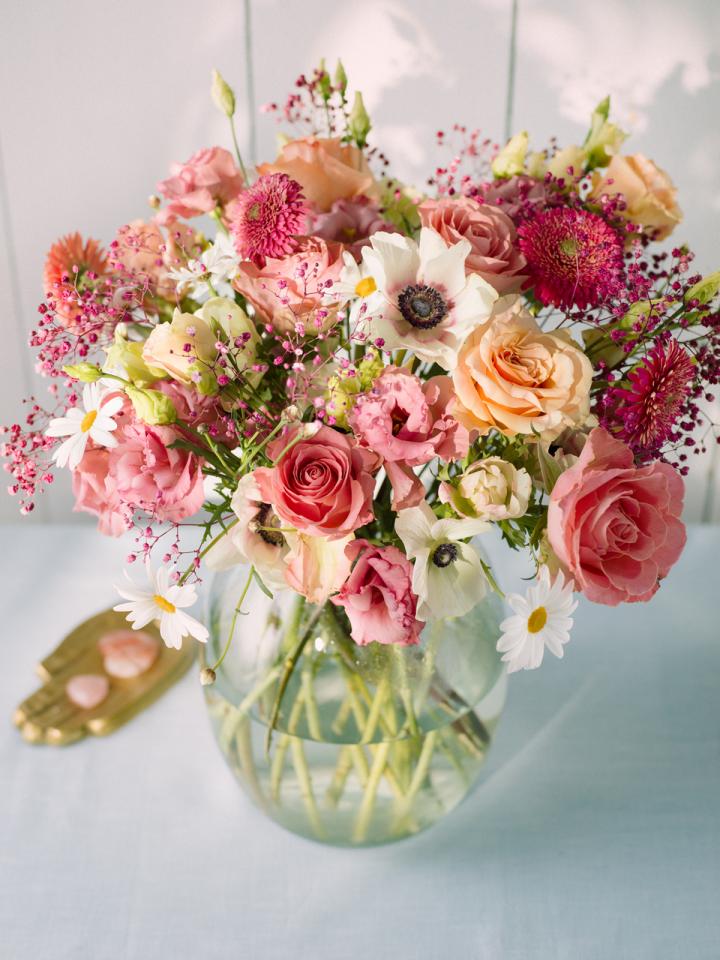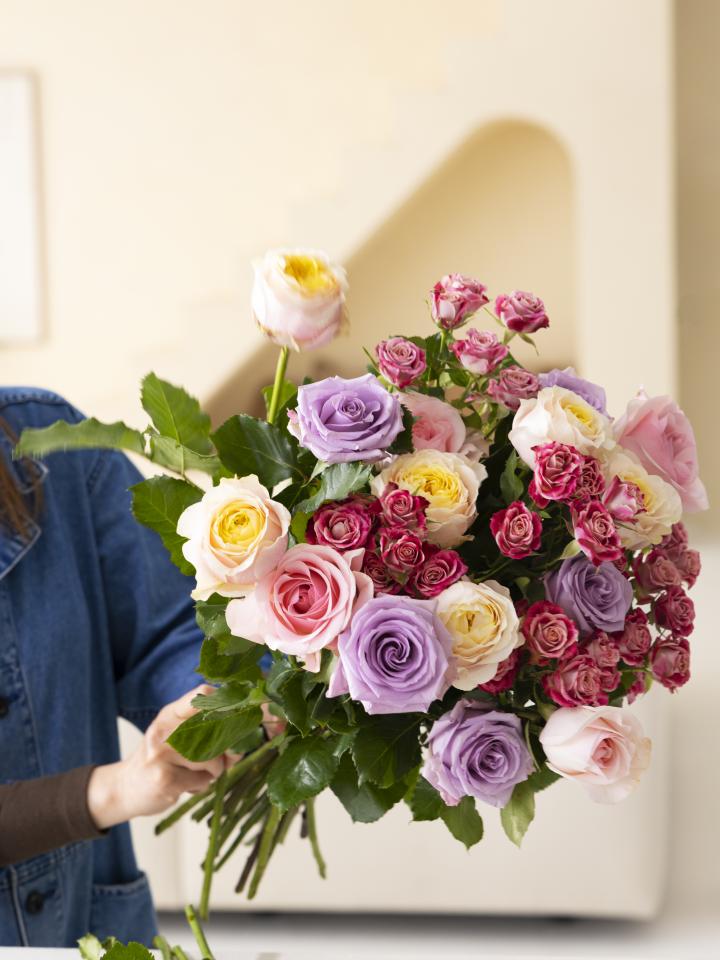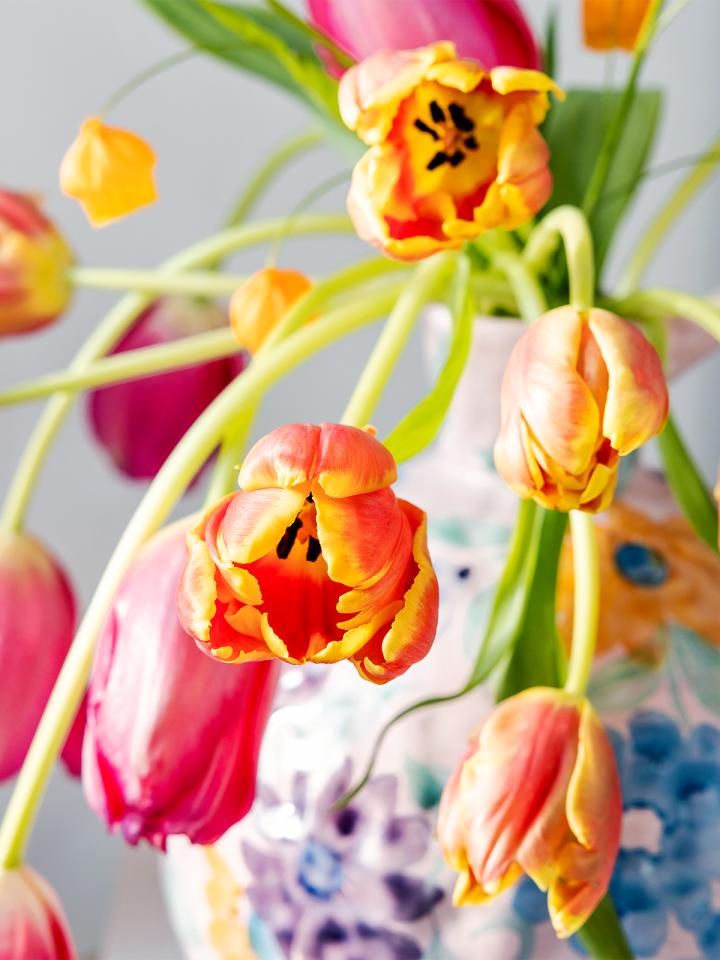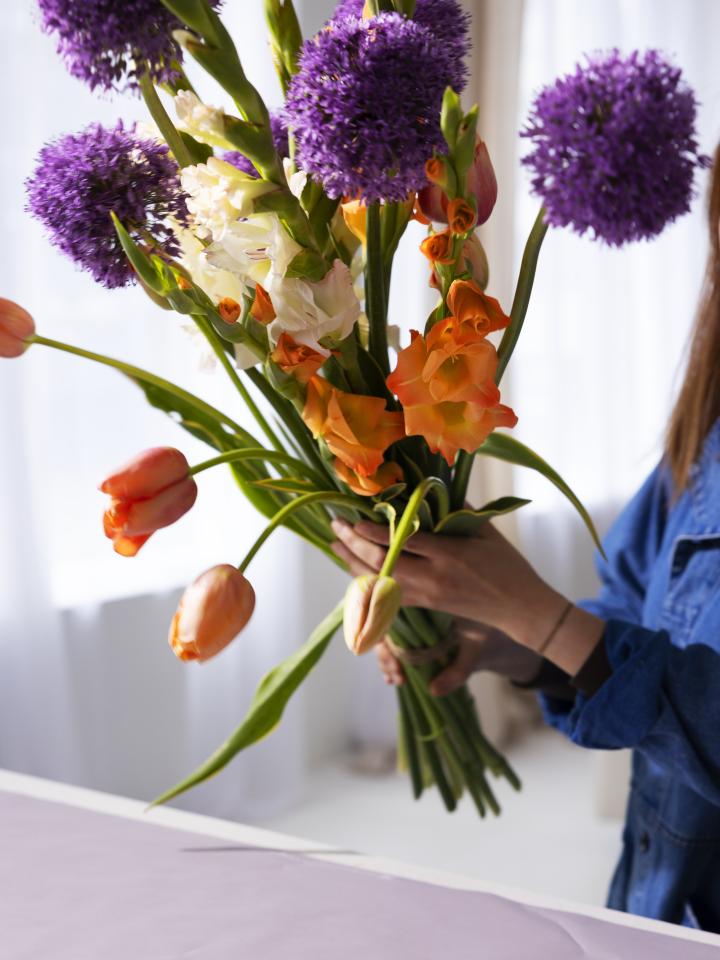HOW TO CHOOSE THE RIGHT VASE FOR A BOUQUET of flowers
Keeping flowers looking beautiful for a long time doesn't depend only on caring for the flowers themselves - your choice of container is also hugely important. Consider the factors below when choosing the right vase for your bouquet:
- Preferably, choose a vase made of glass or glazed ceramic. These hardy materials aren't sensitive to water or scratches and are easy to keep clean. This translates to a longer-lasting bouquet!
- Keep in mind the weight of the flowers. For heavier bouquets, such as a bouquet of sunflowers, use an extra sturdy vase that won't tip over. For lighter bouquets, such as a bouquet of roses, tulips or sweet peas, a less sturdy one is fine.
- Consider the type of flower. Tulips do especially well in a special tulip vase, like this one. Any fragile stems that could use extra support also do well these types of special vases with a 'spout' for each individual stem, which makes them less likely to droop.
- Pay attention to the size of your vase. A too-small vase won't offer enough space for blooming flowers and will look messy. Too large of a vase doesn't offer enough support for the stems and will look too empty.
- Pay attention to the height of your vase. A too-tall vase won't show off the flowers to the max, and a too-low vase won't offer enough support. As a rule of thumb, vases should be around a third to two thirds of the bouquet height.
- Match the shape of the vase to your bouquet. Loose flowers or small bouquets do well in narrow, straight or bottle-shaped vases, while a full and round bouquet looks great in a spherical vase.
- Make sure the look of the vase matches the bouquet and your interior. Use the same shades as the bouquet and/or your home, or choose a contrasting, striking colour that suits your personal style.

How to clean your vase
A clean vase is free from bacteria which can harm your flowers, and keeps blooms in tip-top shape for as long as possible. It's simple to clean any vase in just a few simple steps:
- Rinse your vase with warm water and use a dishwashing brush to remove dirt.
- Clean your vase thoroughly by mixing warm water with a splash of vinegar, lemon juice or scoop of baking soda. If necessary, soak the vase overnight. You can also use a drop of chlorine but this is a less eco-friendly method. (and be careful with children and pets, too).
- Let the vase dry thoroughly. You can turn the vase upside down and let it air dry. For a transparent glass vase you might prefer to dry it with a clean cloth to avoid watermarks or smudges.

how to care for a vase of flowers
Ready to put flowers into your clean vase? With these tips for caring for cut flowers, you'll ensure your flowers stay beautiful for as long as possible:
- Cut the flower stems diagonally with a sharp, clean knife.
- Remove the lower leaves from the stems so that no leaves drop into the vase water. This will cause bacterial growth and reduce the shelf life of your flowers.
- Make sure you have a clean vase with water at the right temperature. Depending on the type of flowers, choose cold, lukewarm or warm water.
- How much water you need depends on the type of flower and the size of the bouquet. A large bouquet needs more water than a few individual stems. Furthermore:
- Flowers with smooth stems, such as roses and tulips, need more water relative to their size to stay beautiful for longer.
Flowers with prickly, hairy stems, such as sunflowers and gerberas, prefer a smaller amount of water.
- Flowers with smooth stems, such as roses and tulips, need more water relative to their size to stay beautiful for longer.
- Add cut flower food to extend the shelf life of your flowers.
- Don't have any cut flower food? In a pinch, you can add vinegar and sugar to the water in your vase*. Before adding the flowers, add a dash of vinegar and a spoonful of sugar to the water. Stir well and put the flowers in. You can also use a drop of chlorine, but this is a less eco-friendly method and you're less likely to have it hanging around your kitchen. Vinegar (or bleach) prevents mould growth and encourages water absorption. Sugar acts as a nutrient for your flowers. Note: if you use chlorine, stick to just one drop per vase!
- Arrange the flowers in your desired way. See our step-by-step plan for arranging a bouquet below.
- Don't put your bouquet in direct sunlight, in a draught or near a heater.
- Don't put your bouquet next to a fruit bowl. Ripening fruit releases ethylene gas, which causes flowers to ripen and wilt.
- Change the vase water regularly, preferably every two days and regardless of whether the water looks dirty or not. Replace the vase water completely (i.e. do not top up, but drain and refresh). If desired, you can add vinegar and sugar again and recut the stems at an angle.
- Has the vase water become dirty but your flowers are still beautiful? Rinse the stems, cut them at an angle again and refresh the vase water.
An extra tip: the advantage of a transparent, glass vase is that you can easily see how much water is left in the vase, whether there are any unwanted leaves hanging in the water and whether the vase water is dirty or not. This allows you to respond faster to the needs of your flowers.
*Home, garden and kitchen remedies like sugar and vinegar do not work miracles and aren't essential. Cut flower food from the florist works best, but the most important thing is to change your vase water regularly and to make sure there are no leaves hanging into the water.

ARRANGING FLOWERS IN A VASE: a STEP-BY-STEP PLAN
Wondering how to arrange your own flowers as beautifully as possible in their vase? Check out the flower arranging step-by-step plan below:
- Work on a tidy flat surface where you can easily arrange the bouquet, for example the kitchen table or next to the kitchen sink.
- Make sure you have a clean, suitable vase. See the tips at the top of this article.
- Cut the flower stems at an angle. Think about how you want to arrange the bouquet in your vase. If you want playful height differences (as in a field bouquet), cut the stems at different heights. If you want a round and full bouquet, cut the flowers at the same height. You can also keep the heights of the flowers as you get them from the florist and trim only a few centimetres off each stem at an angle.
- Remove the lower leaves from the stems, so they don't hang into the vase water later and cause bacterial growth.
- Place the stems in the vase, one at a time, crosswise. Start with the sturdy branches and put them on the outside. Work from the outside in and always put the flowers crosswise next to other flowers. If you don't want a standard bouquet, check out these three original ways to arrange a bouquet.
- Make sure all stems are in the water.
- Give the bouquet a quarter turn every now and then to see if it is nicely and evenly distributed.
- View the bouquet from a distance and move some flower stems around if necessary.
- Give your bouquet a place to shine! Make sure it has a good spot, so not in a draught, in direct sunlight, next to a warm radiator or next to a fruit bowl.
how to make tulips last as long as possible
Brought home a stunningly colourful bunch of tulips? To keep them looking perky as long as possible, peruse our number of tips and tricks specifically pertaining to this gorgeous spring flower. Explore special vases just for tulips and learn why it's better to give tulips time to adapt to their new environment rather than arrangement them straight away. Find out all about tulip care in our complete tulip guide.

a BOUQUET FOR EVERY SEASON
Need inspiration for composing a perfect bouquet? Let yourself be inspired by your favourite colours and flowers, or by bouquets with seasonal flowers! Discover this fresh spring bouquet, a bright summer bouquet, a classic autumn bouquet full of warm colours or a serene and wintery white bouquet.






